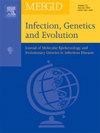评估鹿在北爱尔兰牛分枝杆菌感染传播中的潜在作用。
IF 2.6
4区 医学
Q3 INFECTIOUS DISEASES
引用次数: 0
摘要
牛分枝杆菌是动物结核的病原体,具有广泛的宿主范围-感染,诱导病理并从牛和野生动物宿主传播。为了解野生动物在感染的持续和传播中可能发挥的作用,已经付出了相当大的努力。在美国密歇根州的白尾鹿(Odocoileus virginanus)种群中观察到,受感染的鹿可以将感染传播给同种和同域的牲畜。然而,在其他地区,关于鹿群是作为维持宿主还是外溢宿主存在争议,鹿的密度和与牲畜的接近度等生态环境可能是关键决定因素。在爱尔兰,威克洛郡(County Wicklow)的梅花鹿(Cervus nippon)种群被提议充当维持宿主,这一观察结果与岛上其他地方梅花鹿主要是溢出宿主的观点不一致。在北爱尔兰,政策制定者试图了解提供者在动物结核病流行病学中可能发挥的作用。2019年至2023年在全省范围内对522只鹿进行了扑杀,获得13株经培养确认的牛分枝杆菌分离株(动物流行率为2.5 %)。对这些样本进行了全基因组测序,并对另外4个存档的鹿分离株和190个牛分离株进行了基因组流行病学研究。采用贝叶斯出生-死亡天际线和结构化聚结分析的系统发育方法来跟踪流行病的进展,并估计牛支原体在牛和鹿之间传播的原始计数和率。研究结果与发现的疾病传播的主要驱动因素是受感染的牛相一致,鹿的作用较小。本文章由计算机程序翻译,如有差异,请以英文原文为准。

Assessing the potential role of deer in the dissemination of Mycobacterium bovis infection to cattle in Northern Ireland
Mycobacterium bovis, the causative agent of animal tuberculosis, exhibits a broad host range - infecting, inducing pathology and transmitting from both bovine and wildlife hosts. Considerable effort has been extended to understanding the role wildlife may play in persistence and spread of infection.
Infected cervids can spread infection to conspecifics and sympatric livestock as observed in the white-tailed deer (Odocoileus virginanus) population of Michigan, USA. However, in other territories, there is debate about whether cervids act as maintenance or spillover hosts, with ecological contexts such as deer density and proximity to livestock likely to be key determinants. In Ireland, sika deer (Cervus nippon) populations in County Wicklow have been proposed to act as maintenance hosts, an observation at odds with the view that elsewhere on the island they are primarily spillover hosts.
In Northern Ireland, policy makers sought to understand the role cervids may be playing in the epidemiology of animal TB. A province wide cull of 522 deer, undertaken from 2019 to 2023, yielded 13 culture confirmed M. bovis isolates (animal prevalence 2.5 %). These were subjected to whole genome sequencing, alongside a further four archived isolates from deer and 190 from cattle to undertake a genome epidemiology study. Bayesian phylogenetic methods of birth death skyline and structured coalescent analyses were applied to track epidemic progression and estimate raw counts and rates of M. bovis transmission withing and between cattle and deer. Findings were consistent with the main driver of disease transmission detected being infected cattle, with deer playing a smaller role.
求助全文
通过发布文献求助,成功后即可免费获取论文全文。
去求助
来源期刊

Infection Genetics and Evolution
医学-传染病学
CiteScore
8.40
自引率
0.00%
发文量
215
审稿时长
82 days
期刊介绍:
(aka Journal of Molecular Epidemiology and Evolutionary Genetics of Infectious Diseases -- MEEGID)
Infectious diseases constitute one of the main challenges to medical science in the coming century. The impressive development of molecular megatechnologies and of bioinformatics have greatly increased our knowledge of the evolution, transmission and pathogenicity of infectious diseases. Research has shown that host susceptibility to many infectious diseases has a genetic basis. Furthermore, much is now known on the molecular epidemiology, evolution and virulence of pathogenic agents, as well as their resistance to drugs, vaccines, and antibiotics. Equally, research on the genetics of disease vectors has greatly improved our understanding of their systematics, has increased our capacity to identify target populations for control or intervention, and has provided detailed information on the mechanisms of insecticide resistance.
However, the genetics and evolutionary biology of hosts, pathogens and vectors have tended to develop as three separate fields of research. This artificial compartmentalisation is of concern due to our growing appreciation of the strong co-evolutionary interactions among hosts, pathogens and vectors.
Infection, Genetics and Evolution and its companion congress [MEEGID](http://www.meegidconference.com/) (for Molecular Epidemiology and Evolutionary Genetics of Infectious Diseases) are the main forum acting for the cross-fertilization between evolutionary science and biomedical research on infectious diseases.
Infection, Genetics and Evolution is the only journal that welcomes articles dealing with the genetics and evolutionary biology of hosts, pathogens and vectors, and coevolution processes among them in relation to infection and disease manifestation. All infectious models enter the scope of the journal, including pathogens of humans, animals and plants, either parasites, fungi, bacteria, viruses or prions. The journal welcomes articles dealing with genetics, population genetics, genomics, postgenomics, gene expression, evolutionary biology, population dynamics, mathematical modeling and bioinformatics. We also provide many author benefits, such as free PDFs, a liberal copyright policy, special discounts on Elsevier publications and much more. Please click here for more information on our author services .
 求助内容:
求助内容: 应助结果提醒方式:
应助结果提醒方式:


